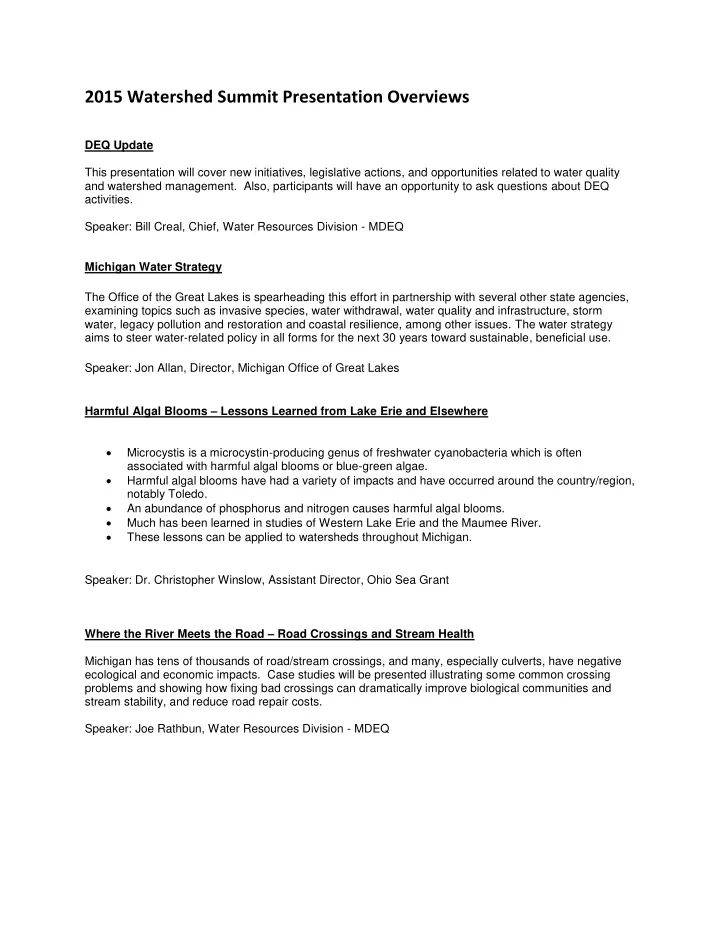

2015 Watershed Summit Presentation Overviews DEQ Update This presentation will cover new initiatives, legislative actions, and opportunities related to water quality and watershed management. Also, participants will have an opportunity to ask questions about DEQ activities. Speaker: Bill Creal, Chief, Water Resources Division - MDEQ Michigan Water Strategy The Office of the Great Lakes is spearheading this effort in partnership with several other state agencies, examining topics such as invasive species, water withdrawal, water quality and infrastructure, storm water, legacy pollution and restoration and coastal resilience, among other issues. The water strategy aims to steer water-related policy in all forms for the next 30 years toward sustainable, beneficial use. Speaker: Jon Allan, Director, Michigan Office of Great Lakes Harmful Algal Blooms – Lessons Learned from Lake Erie and Elsewhere Microcystis is a microcystin-producing genus of freshwater cyanobacteria which is often associated with harmful algal blooms or blue-green algae. Harmful algal blooms have had a variety of impacts and have occurred around the country/region, notably Toledo. An abundance of phosphorus and nitrogen causes harmful algal blooms. Much has been learned in studies of Western Lake Erie and the Maumee River. These lessons can be applied to watersheds throughout Michigan. Speaker: Dr. Christopher Winslow, Assistant Director, Ohio Sea Grant Where the River Meets the Road – Road Crossings and Stream Health Michigan has tens of thousands of road/stream crossings, and many, especially culverts, have negative ecological and economic impacts. Case studies will be presented illustrating some common crossing problems and showing how fixing bad crossings can dramatically improve biological communities and stream stability, and reduce road repair costs. Speaker: Joe Rathbun, Water Resources Division - MDEQ
Natural Resources Conservation Service and Farm Bill Opportunities This presentation will cover the role and mission of the Natural Resources Conservation Service. In addition, the presentation will include an overview of Farm Bill priorities and opportunities to fund implementation of best management practices. Speaker: Kim L. Wieber, Natural Resources Conservation Service Two-Stage Channels This presentation will provide information on design of two-stage ditches and describe their benefits in a watershed or agricultural setting. This session will also cover design considerations and funding opportunities on successful projects in the State. Speaker: Steve Roznowski, P.E., Project Manager – Water Resources Services Group Paying for Soil Saving Performance Make the most efficient use of your conservation dollars! In this session, a pilot project from a Saginaw Bay headwaters area will be showcased to show how watershed modeling technology can measure and incentivize sediment load reduction results. Speaker: Ben Wickerham, Gratiot Conservation District Vegetated Buffer Strips In this session our two speakers will introduce a study on vegetated buffer widths and sediment removal rates and how information from this study is being implemented in the Kawkawlin Watershed via a Great Lakes Restoration Initiative Grant. Speakers: Kevin Wilson, Bay County Conservation District and Russ Beaubien, Spicer Group Ceresco Dam Removal Experience on the Kalamazoo River Given the Ceresco Dam removal experience, common hurtles involving dam removal will be presented including community support, contaminated sediments, sediment management, and funding. This project also involved a significant river rehabilitation component involving native plantings, toe-wood bank protection, and riffle/pool construction. Speaker: Jay Wesley, Michigan Department of Natural Resources, Fisheries Division
Restoring and Protecting Inland Lakes with Natural Shorelines Lakeshore development has caused significant adverse effects on fish and wildlife habitat and water quality in many Midwest lakes (EPA 2007). The Michigan Natural Shoreline Partnership (MNSP) was formed in 2008 to promote the use of natural landscaping and erosion control to protect Michigan’s inland lakes. The partnership brings together technical expertise and organizational support to address informational, educational and policy needs related to natural shoreline development. Presentation will include information on MNSP education programs and supporting resources to promote and implement natural shorelines, an overview of different techniques and wave energy importance in natural shoreline design and native plant recommendations. Speaker: Julia Kirkwood, Water Resources Division - MDEQ MGROW Presents the Middle Grand River Heritage Water Trail The Heritage Water Trail project integrates many objectives of the Middle Grand River Organization of Watersheds. While providing traditional paddling information on access points, the project encourages individuals and groups to recreate locally so they gain an appreciation for the wonderful opportunities the Grand River offers. Along with an appreciation comes a desire to protect and restore the resource. By adding information and photos of historical significance, the paddler will learn about the importance of the river in making the Lansing area what it is today. “Paddle Through History” is the theme of the project aimed at engaging the paddler both immediately and for a lifetime. The project was designed as a means to increase membership in the organization and to inspire additional volunteer efforts to celebrate and enhance our water resources. Speaker: Fred Cowles, Cowles Environmental Keeping Track of Water Levels Using CrowdHydrology CrowdHydrology is an effort to collect crowd sourced hydrologic data. Stream gaging staffs are placed with signage asking passersby to submit water levels via text message. Participating citizens can see their submission in nearly real-time on the CrowdHydrology website (www.crowdhydrology.org). Learn how your watershed can join the CrowdHydrology Network. Speaker: Laura Young, Research Associate, Institute of Water Research - Michigan State University
Recommend
More recommend